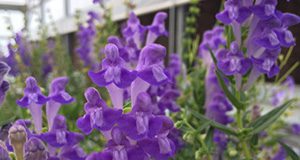Abstract
Scutellaria species (spp.) are perennial, herbaceous plants that are cultivated for both their ornamental and medicinal value. This 5-page document describes the uses and growing requirements of this species. Written by Amanda Morgan and Brian Pearson and published by the UF/IFAS Environmental Horticulture Department, September 2018.
http://edis.ifas.ufl.edu/ep564
References
Awad, R., J. T. Arnason, V. Trudeau, C. Bergeron, J. W. Budzinski, B. C. Foster et al. 2003. "Phytochemical and biological analysis of skullcap (Scutellaria lateriflora L.): a medicinal plant with anxiolytic properties." Phytomedicine. 10(8): 640-649. doi: 10.1078/0944-7113-00374. https://doi.org/10.1078/0944-7113-00374
Bonham, M., J. Posakony, I. Coleman, B. Montgomery, J. Simon, and P. S. Nelson. 2005. "Characterization of chemical constituents in Scutellaria baicalensis with antiandrogenic and growth-inhibitory activities toward prostate carcinoma." Clin. Cancer Res. 11(10): 3905-3914. doi: 10.1158/1078-0432.CCR-04-1974. https://doi.org/10.1158/1078-0432.CCR-04-1974
Cao, X. Y., F. L. Xu, W. L. Wang, J. Wang, S. H. Huang, and X. H. Zhang. 2012. "Responses of Scutellaria baicalensis Georgi yield and root baicalin content to the fertilization rates of nitrogen, phosphorus, and potassium." Ying Yong Sheng Tai Xue Bao = The Journal of Applied Ecology. 23(8): 2171-2177.
Kumar, S., and A. K. Pandey. 2013. "Chemistry and biological activities of flavonoids: an overview." The Scientific World Journal. doi: 10.1155/2013/162750. https://doi.org/10.1155/2013/162750
Miller, K. E. 2001. Scutellaria integrifolia L. Hyssop Skullcap. Framingham, MA: New England Plant Conservation Program.
Morgan, A. 2017. "Influence of Nutrient Availability and Irrigation Frequency on Growth, Quality, and Flavonoid Concentrations in Scutellaria spp. Cultivated within a Protected Greenhouse." Unpublished master's thesis, University of Florida.
Scheck, A. C., K. Perry, N. C. Hank, and W. D. Clark. 2006. "Anticancer activity of extracts derived from the mature roots of Scutellaria baicalensis on human malignant brain tumor cells." BMC Complement. Altern. Med. 6(1): 27. doi: 10.1186/1472-6882-6-27. https://doi.org/10.1186/1472-6882-6-27
Shang, X., X. He, X. He, M. Li, R. Zhang, P. Fan et al. 2010. "The genus Scutellaria an ethnopharmacological and phytochemical review." J. Ethnopharmacol. 128(2): 279-313. doi: 10.1016/j.jep.2010.01.006. https://doi.org/10.1016/j.jep.2010.01.006
Similien, A., D. A. Shannon, C. Wesley Wood, A. M. Rimando, B. W. Kemppainen, E. van Santen et al. 2016. "Shade, Irrigation, and Nutrients Affect Flavonoid Concentration and Yield in American Skullcap." Crop Sci. 56(3): 1213-1224. doi: 10.2135/cropsci2015.03.0186. https://doi.org/10.2135/cropsci2015.03.0186
United States Department of Agriculture, National Resources Conservation Service. 2017. "The PLANTS database." https://plants.usda.gov/core/profile?symbol=SCIN2
Zhang, D. Y., J. Wu, F. Ye, L. Xue, S. Jiang, J. Yi et al. 2003. "Inhibition of cancer cell proliferation and prostaglandin E2 synthesis by Scutellaria baicalensis." Cancer Res. 63(14): 4037-4043.
Unless otherwise specified, articles published in the EDIS journal after January 1, 2024 are licensed under a Creative Commons Attribution-NonCommercial-NoDerivs 4.0 International (CC BY-NC-ND 4.0) license.

